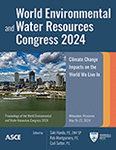An Agent-Based Modeling Approach to Assess the Socio-Economic and Social Equity Impacts of Dynamic Pricing in Residential Water Management
Publication: World Environmental and Water Resources Congress 2024
ABSTRACT
Climate change, urbanization, aging infrastructure, and rising energy costs require water utility managers to consider policies that manage peak water consumption while meeting the needs of water users with affordable, reliable, and safe drinking water. Peak water consumption can exacerbate strains on aging infrastructure and often coincides with peak electricity prices, increasing operation costs for water utilities. Water rates are a part of a demand-side management approach that can elicit water-use behavior changes. As an example, dynamic pricing policies increase the marginal cost of water during periods of peak water use to encourage users to shift their water usage to off-peak times, reducing the strain on infrastructure and the operating cost of the utility. With the adoption of advanced metering infrastructure (AMI) within the water industry, utilities can collect medium-resolution water consumption data to monitor and charge for the timing of hourly water use. However, dynamic pricing can lead to inequitable water costs across a community. Low-income households may have less flexibility in their time-of-use, limiting their ability to respond to dynamic pricing as strategically as high-income households. Households with more inhabitants, which are typically low-income households, typically pay a higher average price than smaller households under conventional tiered pricing policies; this effect can be exacerbated by dynamic pricing. The goal of this research is to assess the differential impact dynamic pricing has on heterogeneous water users. This research develops an agent-based model (ABM) to simulate the response of a community of water users to dynamic pricing. The ABM is applied for a case study, and model outcomes assess the impact that dynamic pricing has on the volume of water consumption, time-of-use, and price of water for households that differ in socio-economic characteristics. This research develops an ABM approach that can be used to quantify inequities in water costs based on household attributes and the ability of water users to respond to demand-side management policies.
Get full access to this chapter
View all available purchase options and get full access to this chapter.
REFERENCES
EPA. 2020. URL: https://www.epa.gov/watersense/how-we-use-water.
Barberán, R., and Arbués, F. 2009. Equity in domestic water rates design. Water Resource Manage 23, 2101–2118. doi:https://doi.org/10.1007/s11269-008-9372-3.
Berglund, E. Z. 2015. Using agent-based modeling for water resources planning and management. Journal of Water Resources Planning and Management doi:https://doi.org/10.1061/(ASCE)WR.1943-5452.0000544.
Cole, G., O’Halloran, K., and Stewart, R. A. 2012. Time of use tariffs: implications for water efficiency doi:https://doi.org/10.2166/ws.2011.123.
Faruqui, A., Sergici, S., and Akaba, L. 2013. Dynamic pricing of electricity for residential customers: the evidence from Michigan. Energy Efficiency 6, 571–584. doi:https://doi.org/10.1007/s12053-013-9192-z.
Grimm, V., et al. 2006. A standard protocol for describing individual-based and agent-based models. Ecological Modelling 198, 115–126. doi:https://doi.org/10.1016/j.ecolmodel.2006.04.023.
Hanemann, W. M., 1997. Urban Water Demand Management and Planning.
Lamolla, P. V., Popartan, A., Perello-Moragues, T., Noriega, P., Saurí, D., Poch, M., and Molinos-Senante, M. 2022. Agent-based modelling to simulate the socio-economic effects of implementing time-of-use tariffs for domestic water. Sustainable Cities and Society 86. doi:https://doi.org/10.1016/j.scs.2022.104118.
Leker, H. G., and MacDonald Gibson, J. 2018. Relationship between race and community water and sewer service in North Carolina, USA. PloS one 13, e0193225–e0193225.
Linkola, L., Andrews, C. J., and Schuetze, T. 2013. An agent based model of household water use. Water (Switzerland) 5, 1082–1100. doi:10.3390/ w5031082.
Mack, E. A., and Wrase, S. 2017. A burgeoning crisis? a nationwide assessment of the geography of water affordability in the United States. PloS one 12, e0169488–e0169488. doi:https://doi.org/10.1371/journal.pone.0169488.
Miller, J., and Page, S. 2007. Complex Adaptive Systems. Princeton University Press.
Molinos-Senante, M. 2014. Water rate to manage residential water demand with seasonality: Peak-load pricing and increasing block rates approach. Water Policy 16, 930–944. doi:https://doi.org/10.2166/wp.2014.180.
Napieralski, J., Sulich, C., Taylor, A., and Draus, P. 2022. Mapping the link between outdoor water footprint and social vulnerability in metro Phoenix, AZ (USA). Landscape and urban planning 226, 104498.
Neville, J. A., Guz, J., Rosko, H. M., and Owens, M. C. 2022. Water quality inequality: a non-targeted hotspot analysis for ambient water quality injustices. Hydrological Sciences Journal 67, 1011–1025. doi:https://doi.org/10.1080/02626667.2022.2052073.
Olmstead, S. M., and Stavins, R. N. 2009. Comparing price and nonprice approaches to urban water conservation 45, 4301. https://doi.org/10.1029/2008WR007227.
Pascual, U., Phelps, J., Garmendia, E., Brown, K., Corbera, E., Martin, A., Gomez-Baggethun, E., and Muradian, R. 2014. Social equity matters in payments for ecosystem services. BioScience 64, 1027–1036. doi:https://doi.org/10.1093/BIOSCI/BIU146.
Perello-Moragues, A., Poch, M., Sauri, D., Popartan, L. A., Noriega, P., and Alvisi, S. 2021. Modelling domestic water use in metropolitan areas using socio-cognitive agents URL: https://doi.org/10.3390/w13081024, doi:10.3390/w13081024.
Rowlands, I. H., and Furst, I. M. 2011. The cost impacts of a mandatory move to time-of-use pricing on residential customers: an Ontario (Canada) case-study. ENERGY EFFICIENCY 4, 571–585. doi:https://doi.org/10.1007/s12053-011-9113-y.
Schaider, L. A., Swetschinski, L., Campbell, C., and Rudel, R. A. 2019. Environmental justice and drinking water quality: are there socioeconomic disparities in nitrate levels in U.S. drinking water? Environmental Health 18. doi:https://doi.org/10.1186/s12940-018-0442-6.
Schwarz, N., and Ernst, A. 2009. Agent-based modeling of the diffusion of environmental innovations — an empirical approach. Technological Forecasting and Social Change 76, 497–511. doi:https://doi.org/10.1016/J.TECHFORE.2008.03.024.
Solis, M., and Bashar, S. B. 2022. Social equity implications of advanced water metering infrastructure. Utilities Policy 79. doi:https://doi.org/10.1016/j.jup.2022.101430.
Wescoat, J. L., Headington, L., and Theobald, R. 2007. Water and poverty in the United States. Geoforum 38, 801–814. doi:https://doi.org/10.1016/j.geoforum.2006.08.007.
Willensky, U., and Rand, W. 2015. An Introduction to Agent Based Modeling. The MIT Press.
Information & Authors
Information
Published In
History
Published online: May 16, 2024
ASCE Technical Topics:
Authors
Metrics & Citations
Metrics
Citations
Download citation
If you have the appropriate software installed, you can download article citation data to the citation manager of your choice. Simply select your manager software from the list below and click Download.
